
3 Most Frequently Asked Questions About Growing Garlic
Growing garlic is very rewarding and easy to do! With minimal effort, and some time spent in the garden, you can grow a bounty of tasty garlic that can be used for months. Homegrown garlic is a perfect addition to your daily cooking, adding it to your favourite dishes. Garlic bulbs comes in a wide variety of different sizes and flavours, so you’re sure to find one that you love!
Types of garlic range from ‘Regular White’ to the purple-striped spicy ‘Russian Red’. Looking for something more mild? Try the large mild-flavoured ‘Elephant’ variety or ‘Chesnok Red’, a full flavoured garlic with a mellow aftertaste.
There are two categories of garlic you can choose from for your garden: softneck and hardneck. Softneck varieties, tends to produce more cloves, but they are smaller in size than its counterpart. Hard neck varieties are larger, stronger in flavor and produce a scape (a flowering stalk). It is important to harvest the scapes in early summer, to direct energy into further growing the garlic bulb. Soft neck garlic varieties do not grow scapes. Softneck varieties grow best in areas with milder winters, while hardneck types performs better in areas that have cold, harsher winter conditions.
Table of Contents
When Should I Plant My Garlic?
The best time to plant your garlic bulbs is in mid-September to October, at least 4 weeks before the ground freezes, and gets too hard to work with. Many varieties can be planted in early spring; however, best results of crops are gained when planted in fall.
Garlic planted in the fall, or the spring will be ready for harvest about the same time, as it is dependent on the lengths of summer days. We recommend garlic cloves to be planted in the fall, so that they can get rooted in the soil right away and then they will go dormant in the winter. Once spring warms up the soil, they will have a jump start on growing and have more time to develop larger cloves within the bulb at harvest time.
How Do I Plant Garlic?
It is best to plant garlic bulbs in well-drained soil, rich with organic matter. Make sure you plant in an area where your garlic will have enough room to produce good roots.
To plant garlic, break the bulbs of your garlic into individual cloves. Each garlic clove will produce one garlic bulb, so that is important to keep in mind when planning out your growing space. Check to make sure your cloves are solid, and for best success, only use the largest cloves, as they will make the biggest garlic bulbs at harvest time. Add these garlic cloves into the prepared soil that you have chosen for your garlic planting bed. Plant cloves root side down (or pointed end up), 8 cm (3”) deep and 15 cm (6”) apart. Remember to space out rows about 30 cm (12″) as some plants can get rather large!
After planting in the fall, it’s important to water and maintain even soil moisture so that roots can develop at the base of each clove. When winter arrives and the ground is frozen, garlic doesn’t require much water. It is in the spring through the early summer, when garlic sprouts push through the soil and the bulbs begin to form, that watering is needed on a regular basis: once every 3-5 days. Garlic likes soil that is not too wet, and not too dry.
In many regions across Canada where the temperatures can reach -40°C (Zone 3) or colder, there can be periods of warming and cooling, of freezing and thawing. A 2-4” inch thick layer of mulch can protect garlic against winter extremes. Mulch helps maintains even soil moisture, consistent temperatures, and it inhibits weeds in the spring. If you choose to mulch, chopped leaves are ideal to use over the garlic bed. In the Spring remember to carefully remove the layers of mulch so that the cloves are at the ideal depth for growing, just like when you first planted them.
When Should I Harvest My Garlic?
Harvesting garlic is the most exciting part of growing garlic at home! The first signs that your garlic is getting ready to harvest is the emergence of scapes, a curly stem that will have a bloom at the end. Remove the scape stems and enjoy them in your culinary dishes. You can reduce watering now an allow the soil to dry to make the harvesting easier. About two weeks later, once the leaves have turned brown, the garlic is now mature and ready to harvest. Carefully dig the bulbs from the ground and gently brush off the soil from around the roots. Do not wash your bulbs in water because the extra moisture accumulates in papery outer layers and around the cloves which creates areas for mold and rot to develop.
Curing the Garlic
With the stalks and leaves still attached, tie them together, or store on drying racks for two weeks. Ensure the that the area you dry your garlic in is well ventilated, with plenty of air circulation, and out of direct sunlight. After two weeks, cut away the dried stalk, leaving 10 cm (4”) attached to the garlic bulb. Trim roots to 1-2 cm (0.5 – 1”) from the base of the bulb. Brush the roots with your fingers to release any remaining dirt and carefully remove the dirty outer layer of the papery garlic wrappers
Storing Garlic
Trim the roots and store garlic bulbs in mesh produce bags, burlap sacks, or wire baskets at cool room temperatures 16-18°C (60-65°F)
Planting garlic is a wonderful addition to every garden, and the reward of being able to use your own homegrown garlic throughout the year is well worth the time spent in the garden. Garlic is easy to grow, and if the right steps are taken, success is sure to be found!
Refer to our Garlic Varieties Poster for details on the various types of garlic. To find a garden centre nearest to you, please visit find a retailer.



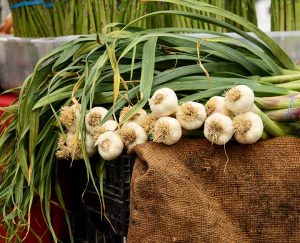
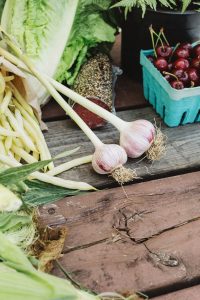
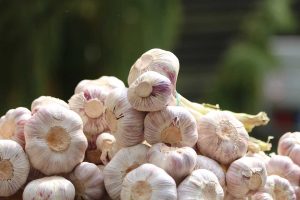
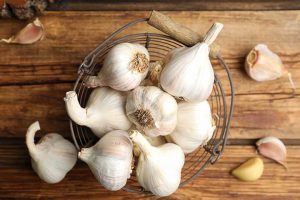
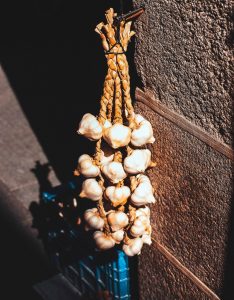
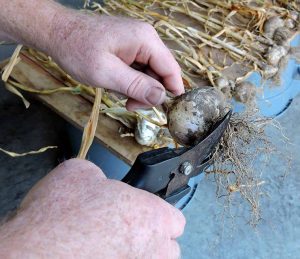
Sue johnston
Can garlic bulbs be planted in a vegetable raised garden instead of in the ground?
Kathleen
I always plant my garlic in raised beds with great results!
Henry Bullock
Henry September 10, 2021, at 7/30 pm, Thank you very much for your very helpful advice about the garlic I never knew there were so many steps to be successful I will follow your advice and hope that gets it right I also appreciated you sending me the Pamphlets on Perennials that the Deer don’t favor as we have lots of them here, also your Pamphlet on drought-tolerant Perennials so thank you again for your welcome advice, Regards Henry
Henry Bullock
I believe I will have a much better garden next year.